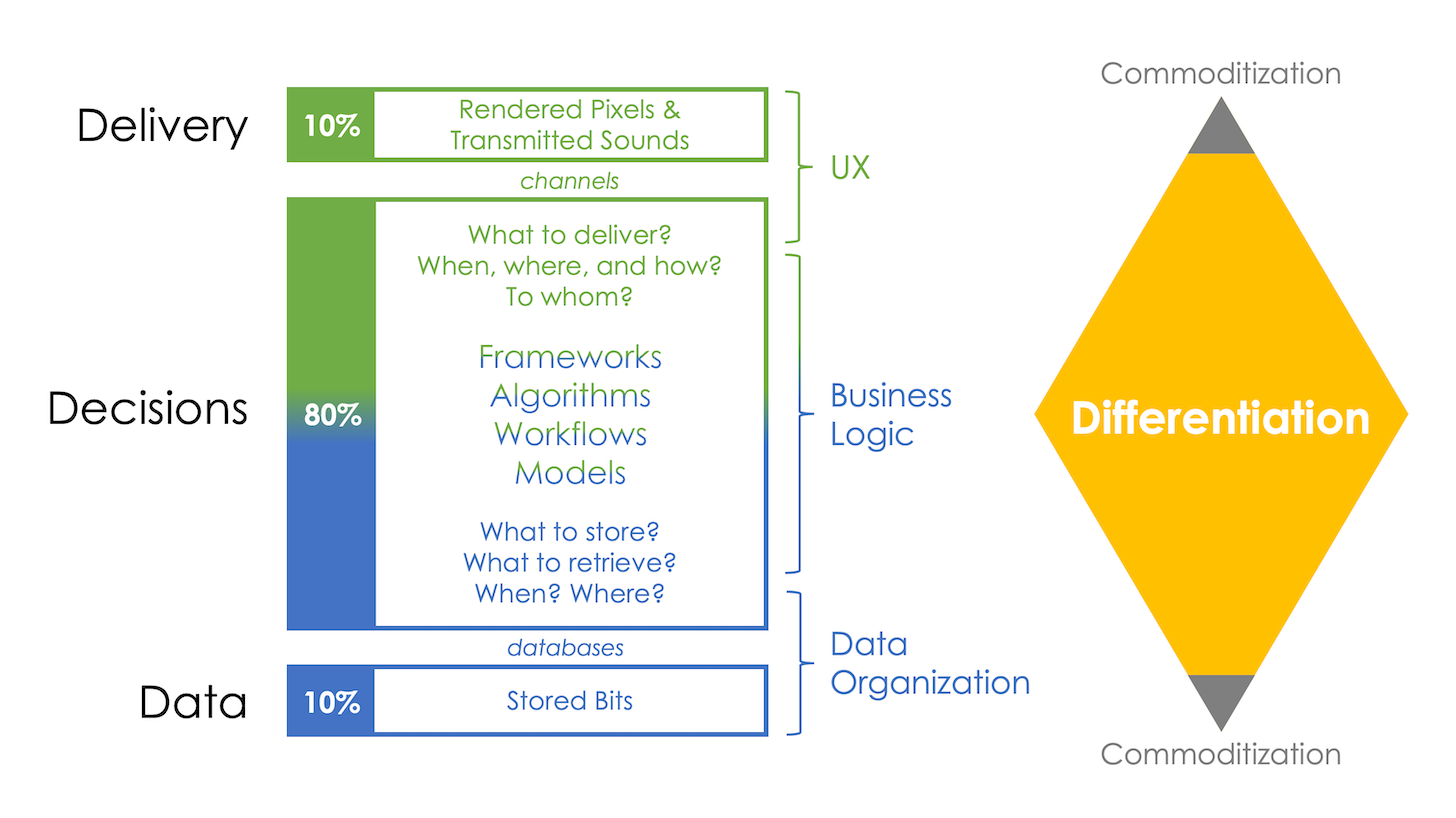
1 of the perennial criticisms of the martech landscape is that “most of these goods all do the exact same thing.” Send out an electronic mail. Render a net web site. Analyze some facts. This criticism has developed louder in proportion to the development of the landscape.
With an progressively exasperated tone, men and women talk to, for illustration, “What’s the point of hundreds of CRMs or promoting automation tools? They are all just storing the exact buyer fields and mail merging them into campaigns.”
I’ve typically experienced two opposite responses to that accusation.
First, I get a very little defensive and say, “Hey, there are genuine innovations that transpire in martech all the time. For instance, you just cannot seem at a solution like DALL-E 2, that magically generates pictures from any description you can specific in terms, and not recognize that, wow, this really is some thing new less than the sunlight.”
But not all improvements in martech are that remarkable. Coming up with the initial several reverse ETL equipment to easily (re)hydrate information into your app stack from your knowledge warehouses was super beneficial. But it wasn’t deserving of a headline in The New York Situations.
So, my fallback response is to confess, “Yeah, I guess you’re proper. All e mail promoting applications kinda do the identical matter. But, hey, on the brilliant facet, that form of commoditized competitors among sellers should really be terrific for you as a marketer. Laws of economics: it really should travel down your value.”
That normally mollified those critics, who mainly just needed me to acquiesce to their intestine-stage belief that the martech landscape was all seem and fury signifying absolutely nothing. But it didn’t sit well with me. It didn’t look to reveal the sheer quantity of variations of products in martech groups nor the enormous quantity of mental funds that held staying invested in them.
Three-Tier Architectures: Details, Selections, Shipping
Let’s begin by recognizing that most program follows a pattern of a few tiers or levels:
- Details — at the base: information saved in a database
- Presentation — at the top rated: what appears on the screen to users
- Business Logic — in the center: selections and circulation among the other two layers
David Raab, the inventor of the CDP category, mapped these to three levels of data, decisions, and shipping and delivery. (I wrote an post last year riffing on that product identified as Facts, Decisioning, Shipping and delivery & Layout to distinguish CDPs from cloud info warehouses, CDWs.)
But these 3 layers are not equivalent in scale or complexity.
The knowledge layer appears to be intuitive as the easiest layer. If you’re conversing about shopper information, these kinds of as in CRM, there are typically a finite amount of fields getting saved. And the most significant fields are normally the exact same: identify, company, title, e mail, cell phone range, handle, and so forth.
Of program, all purchaser information is not totally that homogenized. Unique firms collect unique information and facts all-around purchases, customer behaviors, demographic, firmographics, technographics, and so on. There can be relational knowledge connecting people buyers with campaigns, plan, and associates.
Even so, the amount and dispersion of variation is modest. In other text, the information layer is pretty vulnerable to commoditization.

What about the presentation or delivery layer? Most men and women — specifically UX experts — would say there’s a lot additional scale and complexity listed here. It’s every thing that everybody sees or hears!
Intuitively, there is great variation in presentation. Some interfaces are stunning other folks are unsightly. Some present you accurately what you want, where you want it other people are a incredibly hot mess that your eyes painfully bushwhack via to come across the just one issue you ended up really hunting for.
So presentation is an location of differentiation, not commoditization, suitable?
Essentially, no.
Forgive me for receiving a little bit philosophical in this article, but have confidence in me, there is a significant position to it.
The technical layer of presentation is basically rather constrained. There are only so a lot of pixels, of so many hues, that you can put on a monitor. I’m not chatting about what all those pixels depict — which is anything distinctive, which we’ll get to in a second. The raw pixels and their frequent designs veer toward commodities.
For that subject, if we increase further than just “presentation” to protect other sides of “delivery” — how that presentation basically comes in entrance of another person — that is fairly commoditized way too. The HTTPS protocol for world wide web pages. The SMTP protocol for electronic mail. The SMPP protocol for text messages. These are not just commodities, they are specifications.
Now before designers start off sending me anatomically unflattering wireframes of wherever I can stick this write-up, let me swiftly adhere to up that design and UX are extremely sophisticated and crucial facets of products and solutions and activities that give incredible possibility for differentiation. (Appear, I even set it in bold!)

But the magic and mastery of structure and UX is not in the delivery. It’s in the decisions about what to provide — when, exactly where, how, to whom.
It’s the conclusions in UX that develop differentiation.
Conclusions Are the Wellspring of Differentiation
Most of computer software is decisioning. All those directions operating through processors determining if this, then that, millions of periods per minute. The majority of code in apps is “business logic”, a broad ocean between the seabed of common info and the reasonably slim waves of presentation shipped on the area.
The scale of the decisions layer in computer software is enormous. I have drawn it as 80%, relative to 10% for facts and 10% for supply, in my diagram. But it is possibly closer to 98% vs. 1% and 1% in most applications.

It’s also elaborate. And I signify “complex” in the scientific sense of many interacting pieces — and not just isolated inside that a person application alone. The decisions a single software package app would make are affected by the choices other linked computer software apps make. In a stack of dozens of apps, hundreds of info sources, and 1000’s or hundreds of thousands of end users, all feeding various inputs into a program’s selection-building, you have an astronomical set of prospects.
It is in this complicated atmosphere exactly where distinctive software program apps provide to bear unique algorithms, frameworks, workflows, and styles to make conclusions in diverse approaches.
There are 3 essential details about this selections layer:
- It’s the major part of what composes a application app.
- Collectively, there is a in close proximity to infinite number of distinct probable conclusions.
- These selections can have considerable, substance affect on organization results.
The previous issue must be self-apparent. Businesses contend on the decisions they make. If you never feel you can make unique — better — conclusions than your competition, you should likely take into consideration a career as a hermetic monk. (Ironically, a extremely differentiated selection to make.)
The decisions layer in software is a large canvas for differentiation. And with its possible affect on outcomes, it’s a huge canvas for significant differentiation.
Practically no two program apps — at the very least applications of any major dimension — are the same.
Martech: Commoditized and Differentiated
When you look at the superior-amount types of the martech landscape, this kind of as a massive bucket for CRM, with hundreds of logos, it is honest to say that, confident, in some broad perception, all people apps are the similar. They are all for customer romantic relationship management.

You could also rightfully say that the facts stored in those CRMs are frequently fairly comparable much too. As are the supply channels in which they serve up presentation to employees again-stage and prospects entrance-phase. Via all those lenses, they are commoditized products.
But the gigantic mass of selections in just just about every of these different CRMs differs tremendously.
Devote some time utilizing HubSpot (disclosure: where I do the job), Microsoft Dynamics, and Salesforce, and you will value just how distinct these CRMs are. Surely for your knowledge as a user. But from the myriad of items that lead to differentiated working experience for you in these CRMs springs a fount of distinctive business enterprise selections and customer interactions.
Is a person naturally better than the other individuals? (I’ll resist my particular bias in answering that.) Presented the broad adoption of all a few, you have to conclude that the response to that question is distinctive for distinctive firms.
(Indeed, it is a meta-conclusion to make your mind up which conclusions bundled in a CRM system you choose, to assist you make better choices for your clients, to then assistance them make far better choices in their enterprises, and so on. Turtles all the way down? Nope, it is decisions all the way down.)
And it’s not just these 3 CRMs. It’s the hundreds of many others. Each individual a single created by various people today bringing unique concepts, philosophies, frameworks, and implementation options to the big quantity of decisions embedded in their solution. All of which ripple into differences for how your business enterprise will truly function in zillions of little ways… but which aggregate into not-so-small differences.
More colloquially, this is named opinionated program.
Now, not all those dissimilarities will be superior types. It is a Darwinian current market for sure. Some CRM platforms will thrive others will go extinct. New CRM startups will sprout with new variations. Above time, there may perhaps be more or fewer. But there’s area for various CRMs with distinctive selection layers to legitimately exist, as extensive as each and every 1 has a purchaser foundation — even if, or possibly in particular if, it’s a specialized niche — who favor the one of a kind selections of that vendor.
This dynamic is present across all classes in martech.
Incremental Innovation Is However Innovation
Now, are the differences in the choices layer among two martech solutions in the same classification breakthrough, leap-frogging innovations?
Admittedly, most of the time, no. They are extra usually “incremental innovation” — obtaining improved methods to do a little something, not so considerably developing fully new somethings. But it would be a miscalculation to disdain, “Pffft, that’s only incremental innovation.”
Incremental innovation is continue to innovation. It can meaningfully differentiate 1 vendor from a different and produce great rewards to their buyers.
This why martech has 10,000 solutions that all kinda do the exact same issue — but not truly.












